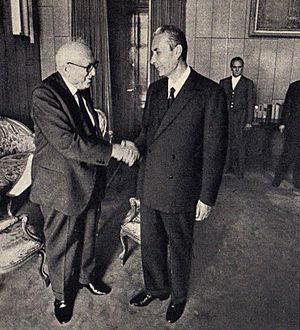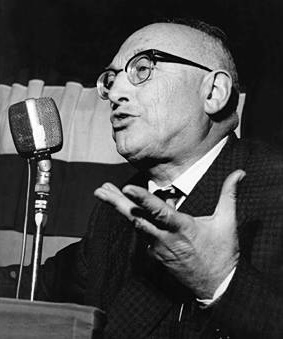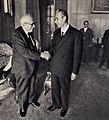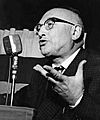Pietro Nenni facts for kids
Quick facts for kids
Pietro Nenni
|
|
|---|---|
 |
|
| Deputy Prime Minister of Italy | |
| In office 4 December 1963 – 24 June 1968 |
|
| Prime Minister | Aldo Moro |
| Preceded by | Attilio Piccioni |
| Succeeded by | Francesco De Martino |
| In office 21 June 1945 – 13 July 1946 |
|
| Prime Minister | Ferruccio Parri Alcide De Gasperi |
| Preceded by | Palmiro Togliatti Giulio Rodinò |
| Succeeded by | Luigi Einaudi Randolfo Pacciardi Giuseppe Saragat |
| Minister of Foreign Affairs | |
| In office 12 December 1968 – 5 August 1969 |
|
| Prime Minister | Mariano Rumor |
| Preceded by | Giuseppe Medici |
| Succeeded by | Aldo Moro |
| In office 18 October 1946 – 2 February 1947 |
|
| Prime Minister | Alcide De Gasperi |
| Preceded by | Alcide De Gasperi |
| Succeeded by | Carlo Sforza |
| Secretary of the Italian Socialist Party | |
| In office 16 May 1949 – 12 December 1963 |
|
| Preceded by | Alberto Jacometti |
| Succeeded by | Francesco De Martino |
| In office 22 August 1943 – 1 August 1945 |
|
| Preceded by | Giuseppe Romita |
| Succeeded by | Sandro Pertini |
| In office 18 April 1933 – 28 August 1939 |
|
| Preceded by | Ugo Coccia |
| Succeeded by | Committee |
| Senator for Life | |
| In office 25 November 1970 – 1 January 1980 |
|
| Appointed by | Giuseppe Saragat |
| Member of the Chamber of Deputies | |
| In office 8 May 1948 – 24 November 1970 |
|
| Constituency | Rome (1948–1958) Milan (1958–1970) |
| Personal details | |
| Born | 9 February 1891 Faenza, Emilia, Italy |
| Died | 1 January 1980 (aged 88) Rome, Italy |
| Political party | PRI (1909–1921) PSI (1921–1980) |
| Spouse | Carmen Emiliani |
| Children | Giuliana Luciana |
| Profession | Journalist |
Pietro Sandro Nenni (born February 9, 1891 – died January 1, 1980) was an important Italian socialist politician. He led the Italian Socialist Party (PSI) for many years. In 1970, he became a senator for life, which is a special honor in Italy. He received the Lenin Peace Prize in 1951. Pietro Nenni was one of the people who helped create the Italian Republic. He was a key figure in Italian left-wing politics from the 1920s to the 1960s.
Contents
Early Life and Political Beginnings
Pietro Nenni was born in Faenza, a town in Emilia-Romagna, Italy. His parents were farmers. After they passed away, a wealthy family placed him in an orphanage. Every Sunday, he would recite his religious lessons for the countess. If he did well, he received a silver coin. He later described this as "generous but humiliating."
In 1909, he joined the Italian Republican Party. By 1908, he was already working as a writer for a republican newspaper in Forlì. At the same time, Benito Mussolini, who later became Italy's Fascist dictator, was editing the socialist newspaper in the same town. In 1911, Nenni was arrested. He had taken part in a socialist protest against Italy's war in Libya, alongside Mussolini. He was imprisoned for seven months.
World War I and Anti-Fascist Efforts
When World War I began, Pietro Nenni believed Italy should join the war. In 1915, he volunteered for the army and fought on the Isonzo front. After being wounded, he returned home and became an editor for the republican newspaper Mattine d'Italia. He supported Italy's role in the war but tried to stay friends with his socialist colleagues. In the final years of the war, Nenni served at the front again.
After the war, he started a group called "Fascio" with some unhappy former soldiers. This group soon dissolved. While Mussolini became a Fascist, Nenni joined the Italian Socialist Party in 1921. This happened after the party split with a group that would form the Italian Communist Party (PCI).
In 1923, after the Fascists marched on Rome, Nenni became the editor of the Socialist Party's newspaper, Avanti!. He actively worked against Fascism. In 1925, he was arrested for publishing a booklet about the Fascist murder of Socialist leader Giacomo Matteotti. In 1926, the Avanti offices were burned, and the paper was banned. Nenni then escaped to France. There, he became the secretary of the Italian Socialist Party.
Years in Exile and Resistance
While living in Paris, Nenni had already met important figures like Léon Blum and Romain Rolland. During his time in exile, Nenni played a crucial role in keeping the Italian Socialist Party alive. He also worked to unite different anti-Fascist groups who had been forced to leave Italy. In 1935, he helped lead the Italian opposition against Mussolini's invasion of Ethiopia.
Nenni then went to fight in the Spanish Civil War with the International Brigades. He helped start and lead the Garibaldi Brigade. After the Spanish Republic lost the war, he returned to France. In 1943, the Germans arrested him in Vichy France. He was then imprisoned in Italy on the island of Ponza.
Tragically, Nenni's third daughter, Vittoria, was part of the French Resistance. She was captured and sent to the Auschwitz concentration camp, where she was killed on July 25, 1943, at the age of 28.
After being freed in August 1943, Nenni returned to Rome. He led the Italian Socialist Party, which had reunited. After Italy surrendered to the Allied forces in September 1943, he became a political leader of the National Liberation Committee. This was a secret group of Italian Partisans fighting against the German occupation.
Post-War Political Leadership
In 1944, Pietro Nenni became the national secretary of the PSI again. He believed his party should work closely with the Italian Communist Party. After Italy was liberated, he took on government roles. He served as Deputy Prime Minister and Minister for the Constituent Assembly in the governments led by Ferruccio Parri and Alcide De Gasperi. In October 1946, he became Minister for Foreign Affairs in De Gasperi's second government.
The close relationship between the PSI and the Communist Party caused some members to leave. In 1947, a group led by Giuseppe Saragat formed a new anti-communist party. During the early years of the Cold War, Nenni was against Italy joining NATO. He worried it could pull Italy into a war between the two superpowers. He preferred Italy to remain neutral. In 1951, he received the Stalin peace prize.

In 1956, Nenni changed his mind about the Communist Party after the Soviet Union's invasion of Hungary. He returned the Stalin Peace Prize and donated the money ($25,000) to the International Red Cross. After this, he slowly guided his party to support Italy's membership in the North Atlantic Treaty Organization (NATO). He also sought to work with the leading party, the Christian Democrats.
Working with the Centre-Left
In the early 1960s, Pietro Nenni helped create a "centre-left opening" in Italian politics. This allowed the Socialist Party to form coalition governments with the Christian Democrats. It was the first time the socialists were back in power since 1947. He formed a centre-left government with Saragat, Aldo Moro, and Ugo La Malfa. He also supported reuniting with Saragat's party.
From 1963 to 1968, Nenni served as Deputy Prime Minister in three governments led by Aldo Moro. In December 1968, he became Minister for Foreign Affairs in the first government of Mariano Rumor. However, he resigned in July 1969 when the centre-left alliance broke apart.
Attempts to reunite the socialists and Saragat's party didn't go well. They formed a joint list for the 1968 Italian general election, but both parties performed poorly. In 1969, a disappointed Nenni mostly retired from active politics. Francesco De Martino took his place as head of the PSI. Nenni was made a senator for life in 1970. In 1971, he ran for President of Italy but was not successful. He passed away in Rome on January 1, 1980. His daughter, Vittoria, who was killed in Auschwitz, is remembered in the writings of Charlotte Delbo.
Pietro Nenni was an atheist.
Images for kids
See also
 In Spanish: Pietro Nenni para niños
In Spanish: Pietro Nenni para niños





